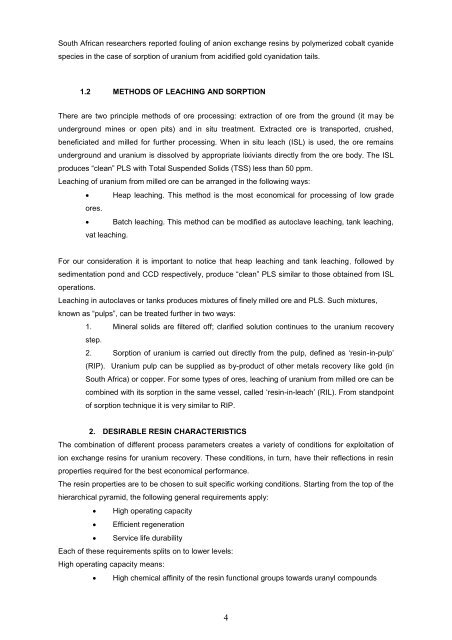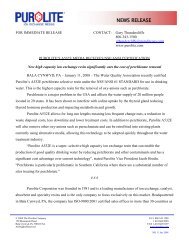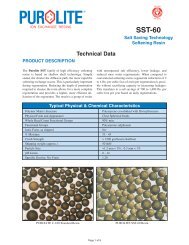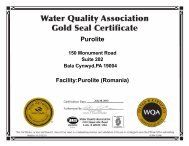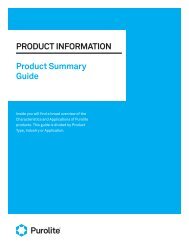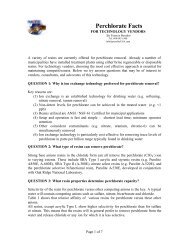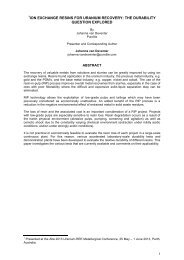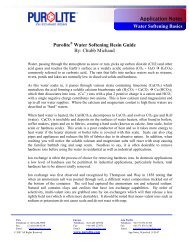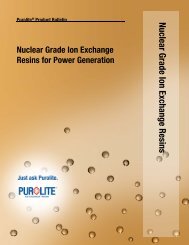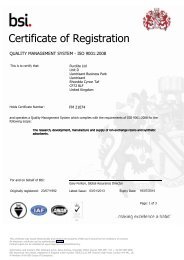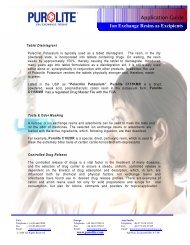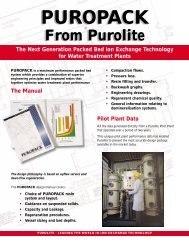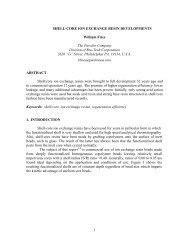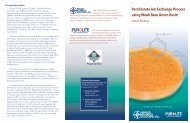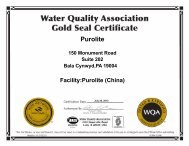Notes of practical application of ion exchange resins in ... - Purolite
Notes of practical application of ion exchange resins in ... - Purolite
Notes of practical application of ion exchange resins in ... - Purolite
- No tags were found...
You also want an ePaper? Increase the reach of your titles
YUMPU automatically turns print PDFs into web optimized ePapers that Google loves.
South African researchers reported foul<strong>in</strong>g <strong>of</strong> an<strong>ion</strong> <strong>exchange</strong> <strong>res<strong>in</strong>s</strong> by polymerized cobalt cyanidespecies <strong>in</strong> the case <strong>of</strong> sorpt<strong>ion</strong> <strong>of</strong> uranium from acidified gold cyanidat<strong>ion</strong> tails.1.2 METHODS OF LEACHING AND SORPTIONThere are two pr<strong>in</strong>ciple methods <strong>of</strong> ore process<strong>in</strong>g: extract<strong>ion</strong> <strong>of</strong> ore from the ground (it may beunderground m<strong>in</strong>es or open pits) and <strong>in</strong> situ treatment. Extracted ore is transported, crushed,beneficiated and milled for further process<strong>in</strong>g. When <strong>in</strong> situ leach (ISL) is used, the ore rema<strong>in</strong>sunderground and uranium is dissolved by appropriate lixiviants directly from the ore body. The ISLproduces “clean” PLS with Total Suspended Solids (TSS) less than 50 ppm.Leach<strong>in</strong>g <strong>of</strong> uranium from milled ore can be arranged <strong>in</strong> the follow<strong>in</strong>g ways: Heap leach<strong>in</strong>g. This method is the most economical for process<strong>in</strong>g <strong>of</strong> low gradeores. Batch leach<strong>in</strong>g. This method can be modified as autoclave leach<strong>in</strong>g, tank leach<strong>in</strong>g,vat leach<strong>in</strong>g.For our considerat<strong>ion</strong> it is important to notice that heap leach<strong>in</strong>g and tank leach<strong>in</strong>g, followed bysedimentat<strong>ion</strong> pond and CCD respectively, produce “clean” PLS similar to those obta<strong>in</strong>ed from ISLoperat<strong>ion</strong>s.Leach<strong>in</strong>g <strong>in</strong> autoclaves or tanks produces mixtures <strong>of</strong> f<strong>in</strong>ely milled ore and PLS. Such mixtures,known as “pulps”, can be treated further <strong>in</strong> two ways:1. M<strong>in</strong>eral solids are filtered <strong>of</strong>f; clarified solut<strong>ion</strong> cont<strong>in</strong>ues to the uranium recoverystep.2. Sorpt<strong>ion</strong> <strong>of</strong> uranium is carried out directly from the pulp, def<strong>in</strong>ed as ‘res<strong>in</strong>-<strong>in</strong>-pulp’(RIP). Uranium pulp can be supplied as by-product <strong>of</strong> other metals recovery like gold (<strong>in</strong>South Africa) or copper. For some types <strong>of</strong> ores, leach<strong>in</strong>g <strong>of</strong> uranium from milled ore can becomb<strong>in</strong>ed with its sorpt<strong>ion</strong> <strong>in</strong> the same vessel, called ‘res<strong>in</strong>-<strong>in</strong>-leach’ (RIL). From standpo<strong>in</strong>t<strong>of</strong> sorpt<strong>ion</strong> technique it is very similar to RIP.2. DESIRABLE RESIN CHARACTERISTICSThe comb<strong>in</strong>at<strong>ion</strong> <strong>of</strong> different process parameters creates a variety <strong>of</strong> condit<strong>ion</strong>s for exploitat<strong>ion</strong> <strong>of</strong><strong>ion</strong> <strong>exchange</strong> <strong>res<strong>in</strong>s</strong> for uranium recovery. These condit<strong>ion</strong>s, <strong>in</strong> turn, have their reflect<strong>ion</strong>s <strong>in</strong> res<strong>in</strong>properties required for the best economical performance.The res<strong>in</strong> properties are to be chosen to suit specific work<strong>in</strong>g condit<strong>ion</strong>s. Start<strong>in</strong>g from the top <strong>of</strong> thehierarchical pyramid, the follow<strong>in</strong>g general requirements apply: High operat<strong>in</strong>g capacity Efficient regenerat<strong>ion</strong> Service life durabilityEach <strong>of</strong> these requirements splits on to lower levels:High operat<strong>in</strong>g capacity means: High chemical aff<strong>in</strong>ity <strong>of</strong> the res<strong>in</strong> funct<strong>ion</strong>al groups towards uranyl compounds4


